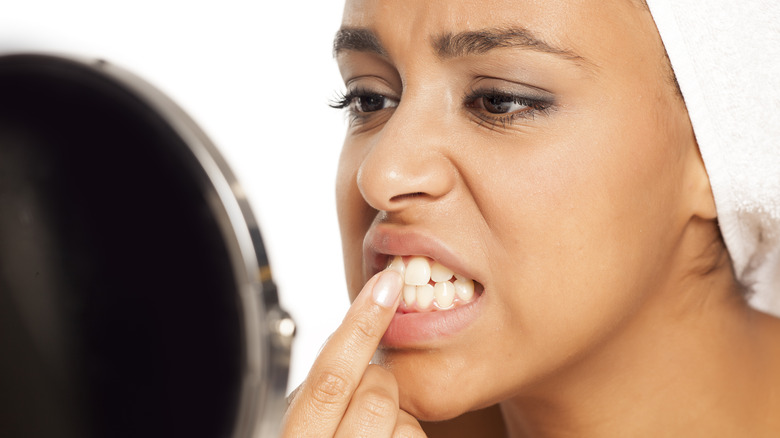Professional teeth-whitening treatments can be expensive. Not only that, but a 2024 review published in The Scientific World Journal found that certain laser-whitening treatments (such as those used in dental offices) can potentially damage tooth pulp and lead to increased sensitivity.
If you’d prefer to go the laser-free route, DIY whitening treatments can be a great alternative. Not only are they less costly, but they can be done from the comfort of your own home. Some popular methods include rinsing one’s mouth with coconut oil or occasionally brushing your teeth with a hydrogen peroxide or baking soda solution (via Medical News Today).
After using these whitening agents, some people opt to plaster their teeth with strips of aluminum foil to preserve contact with these whitening agents for a longer stretch of time. Similar to wrapping aluminum foil around sections of our hair when getting highlights, foil may help these chemicals to more effectively set in. While it may sound good in theory, experts caution that this at-home method of teeth whitening comes with some risks, including pain, gum inflammation, and enamel erosion.
Potential negative effects of using foil to whiten teeth

The process of using aluminum foil to whiten teeth involves creating a paste mixture made up of water and baking soda, according to experts at Seaglass Dental Care. Some people may also add salt, hydrogen peroxide, or toothpaste (via B. Weiss). Then, they either paint the solution onto a strip of aluminum foil or onto the teeth directly with the help of a toothbrush or their finger. Finally, they wrap a strip of foil around the front and back of the teeth and leave it in place for 60 minutes.
Unfortunately, the abrasiveness of salt and/or baking soda can break down tooth enamel, especially when left in direct contact with teeth for so long. Hydrogen peroxide is also a strong ingredient that, with prolonged exposure, can lead to gum irritation. Even more, if you were to accidentally chew on the foil, it could trigger a small electrical charge that may aggravate nerves in the teeth and lead to subsequent pain or discomfort. Those who have crowns or fillings are particularly at risk.
Stick to these at-home teeth-whitening strategies instead

At the end of the day, there is no definitive scientific evidence that applying an at-home whitening paste and wrapping one’s teeth in aluminum foil is a safe or effective way to remove tooth stains (via Seaglass Dental Care). Rather, patients are better off sticking with more conventional at-home whitening treatment methods. This includes using a whitening toothpaste, which is less abrasive on teeth than harsh chemical treatments (via Lambton Family Dental).
Alternatively, you can consult with your dentist or pharmacist about buying an at-home whitening kit. There are many different types of whitening kits, such as those that include brushes, adhesive strips, trays, mouthwash, and more. Check with a healthcare professional to see which option may be best for you. Even better, your dentist may be able to offer a personalized at-home whitening kit specifically fitted to your teeth.
In addition to using whitening products, individuals can also implement healthy habits to keep tooth staining at bay. For example, limiting the consumption of beverages and food items that promote staining, such as sodas or coffee, can help protect against the development of tooth discoloration in the first place.




